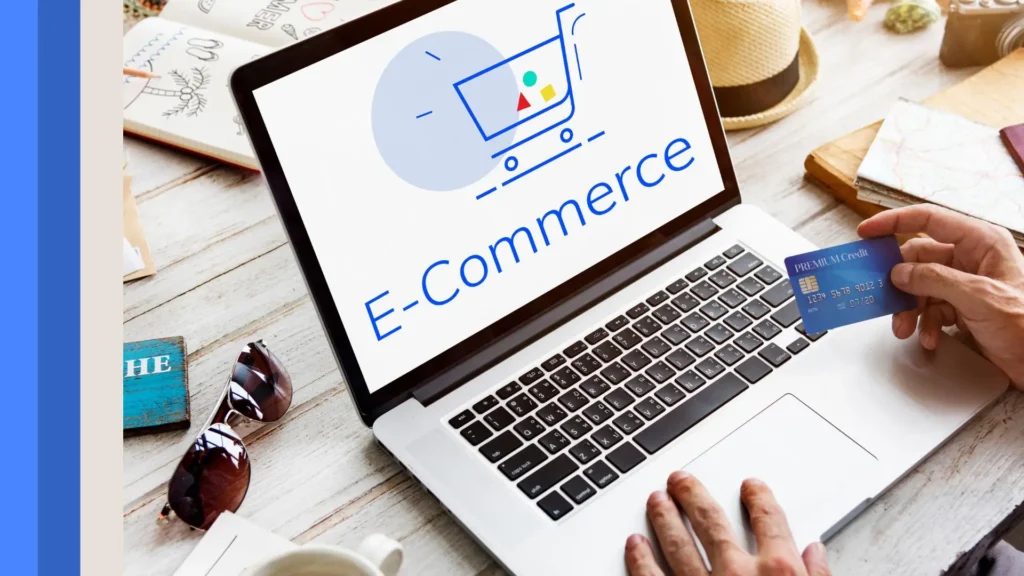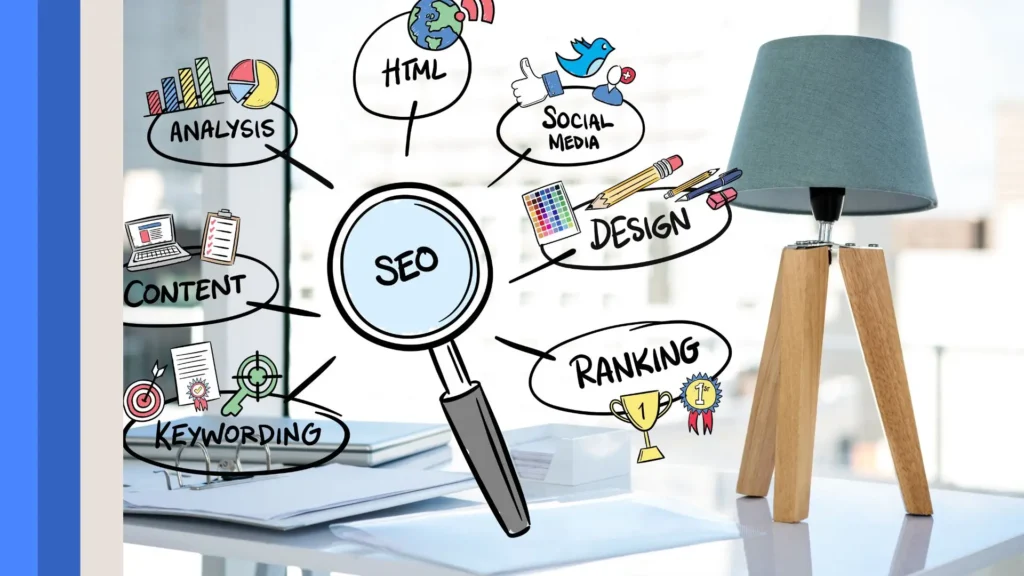E-commerce website design includes both the look and the features of an internet store. It comprises layouts, user interface, user experience, branding, mobile responsiveness, and additional items. Developing a platform that both looks good and is intuitive, helping users shop without issues, is the main aim.
- Essential Guidelines in Design
- What Makes Design Essential
- 1. Accessibility Considerations
- 2. Building an E-commerce Website in the Development Phase
- 3. Things That Make a Successful E-commerce Site
- 4. Connecting Search Engine Optimization with Digital Marketing
- 6. Launch takes place after Testing
- 7. Caring for the Software After You Release
- Conclusion: E-commerce website design & development
- FAQ’s
Essential Guidelines in Design
When designing, emphasize what your users need and how they act.
Keep your page simple and uncluttered to make things easy for site visitors.
Size, color, and placement should differentiate the important things in your design.
Match the design with your brand so customers easily recognize and trust you.
You should design your site so it looks good and functions well on any device.
What Makes Design Essential
The homepage serves as the shopfront and must grab your interest right away.
Users should be able to find products easily, as the site should be easy to navigate.
Product Pages: High-resolution pictures, thorough explanations, the price, customer feedback, and effective buttons.
Advanced search and predictive search are available for ease of use.
Cart and Checkout: Made easy with trackers, different ways to pay, and information that reassures you.
Typography and color are used in all areas of UI design People’s connection to a design is influenced greatly by its typefaces and colors. Pick fonts that are visually suitable for use and color combinations that fit your identity, as long as they are easy for everyone to read.
1. Accessibility Considerations
Make your e-commerce site easy for all users to access. Add alt tags for images, organize your headings properly, and ensure users can use the website using only a keyboard.
| Stage | Key Elements |
|---|---|
| 1. Planning | Business goals, audience targeting, product types, pricing, platform selection |
| 2. Design | UI/UX, branding, typography, color, mobile responsiveness, homepage & product page layout |
| 3. Development | Frontend (HTML, CSS, JavaScript, React/Vue), Backend (PHP, Python, Node.js), APIs, security |
| 4. Testing & Launch | Cross-browser/device testing, load testing, UX feedback, vulnerability scanning, soft launch |
| 5. Post-launch Care | Site monitoring, product/content updates, plugin/software updates, user feedback |
| 6. Marketing & SEO | Keyword research, blogs, email campaigns, social media, influencer partnerships, paid ads |
| 7. Security & Compliance | Business goals, audience targeting, product types, pricing, and platform selection |
2. Building an E-commerce Website in the Development Phase
The process of developing plans and strategies.

A good plan should be in place before any coding begins. Make clear what your business wants to achieve, who will buy your product, what your product is, how much you will charge, and the features you plan to include. Use a platform that suits your shopping website best.
Top E-commerce Platforms
- Shopify is designed to be simple and hosted, perfect for businesses of all sizes.
- Magento: It is very flexible and can be adapted to large businesses’ needs since it is open-source.
- WooCommerce lets you enjoy flexibility and control with your WordPress site.
- BigCommerce: A SaaS platform able to handle your expanding business needs and offers a variety of features.
Developing the site’s frontend means that you design the part of the site that viewers see. Technologies include:
The three main technologies used are HTML, CSS, and JavaScript.
Technologies such as React.js or Vue.js
Working well with APIs as well as third-party apps (e.g., for payments and statistics)
The backend processes data, user accounts, and applications running on the server. Among its main elements are:
Programming languages built for servers, such as PHP, Python, and Node.js
Two main databases are covered: MySQL and MongoDB.
The site uses SSL, encrypts data, and provides secure authentication.
With a powerful Content Management System, you can quickly modify products, monitor stock, and publish your content. Make sure your preferred content management system has a simple and clean link with your chosen platform.
Implement useful features into your website with plugins that provide email marketing, CRM support, and help with inventory and accounting setup.
3. Things That Make a Successful E-commerce Site
- Strong Images and Clear Descriptions are Important in Online Storefronts. Employ several views, use functions to focus in close, and show videos of your items to attract attention. Be sure to describe your reviews with interesting and SEO-compatible descriptions.
- Let your community review and share their feedback for noteworthy products. Influence people’s decisions to buy based on what other customers say and how they rate your products.
- Sorting and filtering products by price, category, size, color, brand, and so on will help users discover what they are searching for more easily.
- Many visitors reach your site using mobile devices. Design your website so it can be accessed on any device easily.
- Make it easy for customers to pay with different types of secure payment gateways. Make certain that all your payments are PCI compliant and add trust badges to gain people’s trust
- Few Steps to Checkout: Try to make the last part of the process as simple as possible. Have a guest checkout service and clearly show your shipping offers and costs.
- Allow users to keep items they want for future visits. Because of this, there is a greater chance of users returning and buying things.
- You might also suggest other merchandise to customers using AI to help boost the number of people who buy from you on every visit.
- Help your customers through Live Chat and Customer Support so that they can get instant support and fast answers.
- Invite clients back with the help of rewards, coupons, and special promotions.
To optimize your website for search engines, don’t forget to structure its pages, use meta tags, invest time in descriptions, and pick the right URLs. Focus on:
- Keyword research
- On-page SEO

4. Connecting Search Engine Optimization with Digital Marketing
Site speed, having a mobile-responsive site, and using schema markup are considered technical SEO.
Starting a blog gives your audience value and helps improve your website’s search ranking.
Email companies should offer email campaigns for products that customers have reportedly left behind, ongoing promotions, and product suggestions. With segmentation and personalization, your communication can become more interesting to the customer.
Integrate with Social Media: Give your customers a way to easily share your photography and link your social pages together. You may want to advertise on Instagram and Facebook.
Partner with influential people in your area to help you reach many new and interested viewers or buyers.
Google Ads and social media advertising can help you target different groups of people and raise your website’s traffic. Keep an eye on the return and improve your campaign strategies.
If you use Affiliate Marketing, others have the chance to make money by promoting your products.
5. Secure and Compliant
Security is the most important aspect of e-commerce. Allowing customers to enter confidential information requires safety.
Rules for Securing Your Data:

- HTTPS should be used to secure data while moving between servers and clients.
- Obey GDPR as well as other privacy laws.
- Choose solid login and user authentication for your application.
- Be sure to update both your WordPress site and any plugins often.
- Describe the data management on your site and get the required permission from visitors. When people are confident in their company, the company is more transparent.
- Make it a habit to back up your data and figure out how you’d recover if something happened to your services.
6. Launch takes place after Testing
Take time to test the site using different browser products on various digital devices before it goes live.
Testing Checklist:
- Testing your website forms, links, and how you navigate the site
- Running load speed and stress testing on products
- The process of looking for security defects (vulnerability scanning)
- Testing how people use and interact with a website (UX feedback)
- Compatible with multiple browsers and devices
It is helpful to let a limited group begin using your app and share their ideas. Get some responses from people and update the app before it is officially launched.
Announcing Your Launch: Use email, teasers, and social media to make people eager for your product. Run sales events that are only available to those who purchased during the early days of your store.
7. Caring for the Software After You Release
You should regularly improve and update your website for e-commerce.
Ongoing Activities:
- Assess the operation of the site and the people who access it most often
- Be sure that all the product details available on your website are current.
- Help the site operate more quickly and consistently
- Experimenting with several treatments to keep getting better
- Always maintain that your software and plugins are in their latest version.
- As part of the Customer Feedback Loop, it’s important to ask customers for reviews and suggestions. Try to answer and implement changes when you can.
- Using AR, voice search, or AI chatbots will help you stay ahead of your competition.
Conclusion: E-commerce website design & development
Creating an e-commerce website may be complicated, but it is very satisfying. A well-made website depends on good planning, good user experience, strong features behind the scenes, strong security, and effective marketing. Building a well-made e-commerce site allows both startups and already growing companies to raise their brand awareness, help customers, and boost their overall sales performance. If companies keep up with design trends and technological advancements, they can develop online stores capable of meeting today’s digital market’s wants.
Threading design ideas, programming, SEO, and secure logistics ensure the website remains seamless, interesting, and dependable for customers. Because customers expect more, having the latest knowledge and taking advantage of what’s new in technology will help e-commerce companies succeed.
FAQ’s
How long it takes usually depends on what you want to include in your app. A simple e-commerce site is usually done in 4 to 6 weeks, whereas more advanced ones with unique features can take many months.
People have many different approaches. If you’re just starting, Shopify is a good choice, Magento can handle the needs of large firms, WooCommerce works best for WordPress, and BigCommerce makes growing easy.
Building an e-commerce website can cost a few hundred dollars for basic sites or tens of thousands for complicated and fully featured ones. The amount you pay is affected by the design, features, platform, and integrations you need.





